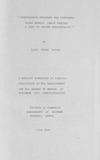| dc.description.abstract | Standard one enrolment present a recurring problem
to both the parents and the authorities in the urban
centres in Kenya. The study detailed in this report
sought to represent the standard one enrolment in
Nakuru Municipality as a Markovian Model and to use
the Model to predict the demand for standard one for
the future.
Data on standard one enrolment from 1969 to 1988
and the demand for standard one places for 1988 were
collected from the Municipal council records.
Part of the data cOllected was used to build a
Model of the system and part was used to validate the
said Model. The model was then used with the 1989
demand to predict the demand for 1990, 1991 and
1992. Similar analysis was performed for the boys
only, the girls only and both boys and girls data
combined.
The results of the study indicate that the
demand for standard one will be greatest in the
central zone, followed by the western and the eastern
zones respectively. The boys demand for standard
one places on the other hand will be greatest in the
eastern zone followed by the central and then the
western zones. The girls demand for standard one
places will be greatest in the western zone followed
by the central zone and the eastern zone respectively.
vJith such results, it is reconunended in this
report for the Municipal council to concentrate their
resources like administrative effort, time, money and
personnel in the central zone, for administering in
the area where demand will be greatest. It would
also be appropriate to use the results given above
as a resource allocation measure, so that resources
are distributed equitably among the zones. Finally,
the Model may be used to allocate most of the girls'
exclusive facilities (like girls only schools) to
the West and most of those exclusive to the boys
(like boys only schools) to the East. | en |

